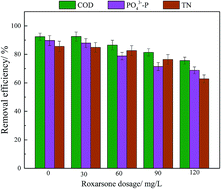Acute and chronic effects of roxarsone on biological nitrogen and phosphorus removal and its mechanism†
Abstract
Roxarsone is often used in livestock and poultry feed and is discharged into wastewater treatment plants after consumption. The potential toxicity of roxarsone to activated sludge in wastewater treatment plants has been attracting increasing concern. However, the acute and chronic toxicities of roxarsone to biological nutrient removal (BNR) have never been reported in the literature. In this paper, the potential effects of short-term and long-term exposure to different concentrations of roxarsone in the range of 0–120 mg L−1 on the performance of BNR were investigated. The experimental results show that short- and long-term exposure to low concentrations of roxarsone (0–30 mg L−1) had a negligible influence on nitrogen and phosphorus removal. However, a high concentration of roxarsone (120 mg L−1) seriously inhibited biological phosphorus removal and denitrification. Mechanistic investigations suggested that the high concentration of roxarsone was capable of inhibiting the synthesis and subsequent oxidation of intracellular polyhydroxyalkanoate, which reduced the efficiencies of aerobic phosphorus uptake and denitrification. Further study showed that high concentrations of roxarsone could inhibit the activities of key enzymes and reduce the relative abundance of microorganisms responsible for BNR.



 Please wait while we load your content...
Please wait while we load your content...